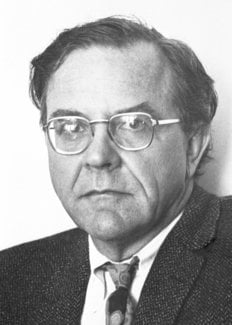Geoffrey Wilkinson
Biographical

I was born in Springside, a village close to Todmorden in west Yorkshire on July 14th, 1921. The house where I was born and indeed most of the village has been demolished by the local council as being unfit for habitation. My father, and his father, also Geoffrey, were both master house painters and decorators, the latter, youngest of twelve children having migrated from Boroughbridge in Yorkshire about 1880. My mother’s family were originally of hill farming stock but many of my relations were weavers in the local cotton mills and indeed my mother went into the mill at an early age. My first introduction to chemistry came at a quite early age through my mother’s elder brother. A well known organist and choirmaster he had married into a family that owned a small chemical company making Epsom and Glauber’s salt for the pharmaceutical industry. I used to play around in their small laboratory as well as go with my uncle on visits to various chemical companies.
The oldest of three children, I was educated in the local council primary school and after winning a County Scholarship in 1932, went to Todmorden Secondary School. This small school has had an unusual record of scholarly achievement, including two Nobel Laureates within 25 years. I actually had the same Physics teacher as Sir John Cockcroft, but physics was never my favourite subject.
In 1939 I obtained a Royal Scholarship for study at the Imperial College of Science and Technology where I graduated in 1941. As it was wartime, I was directed to stay on and did some research under the supervision of my predecessor, Professor H.V.A. Briscoe. In late 1942, Professor F.A. Paneth was recruiting young chemists for the nuclear energy project which I joined. I was sent out to Canada in January 1943 and remained in Montreal and later Chalk River until I could leave in 1946. Having been attracted by the prospect of California, I wrote to, and was accepted by Professor Glenn T. Seaborg. For the next four years in Berkeley I was engaged mostly on nuclear taxonomy and made many new neutron deficient isotopes using the cyclotrons of the Radiation Laboratory.
On a visit in 1949 to England, Briscoe advised me that I was unlikely to get an academic position in England in nuclear chemistry so that when I went as Research Associate to the Massachusetts Institute of Technology in 1950, I began to return to my first interest as a student – transition metal complexes such as carbonyls and olefin complexes.
In 1951 I was offered an Assistant Professorship at Harvard University, largely because of my nuclear background. I was at Harvard from September 1951 until I returned to England in December, 1955, with a sabbatical break of nine months in Copenhagen in Professor Jannik Bjerrum’s laboratory as a John Simon Guggenheim Fellow. At Harvard, I still did some nuclear work on excitation functions for protons on cobalt but I had already begun to work on olefin complexes so that I was primed for the appearance of the celebrated Kealy and Pauson note on dicyclopentadienyliron in Nature in early 1952.
In June 1955, I was appointed to the chair of Inorganic Chemistry at Imperial College in the University of London, which, at that time was the only established chair in the subject in the United Kingdom and took up the position in January 1956. I have been at the College ever since and have worked, with a relatively few students and postdoctoral fellows, almost entirely on the complexes of transition metals. I have been much interested in the complex chemistry of ruthenium, rhodium and rhenium, in compounds of unsaturated hydrocarbons and with metal to hydrogen bonds. The latter led to work on homogeneous catalytic reactions such as hydrogenation and hydroformylation of olefins.
In 1952 I married Lise Sølver, only daughter of Professor and Mrs. Svend Aage Schou, lately Rector of Denmark’s Pharmaceutical High School and we have two daughters.
This autobiography/biography was written at the time of the award and later published in the book series Les Prix Nobel/ Nobel Lectures/The Nobel Prizes. The information is sometimes updated with an addendum submitted by the Laureate.
Sir Geoffrey Wilkinson died on September 26, 1996.
Nobel Prizes and laureates
Six prizes were awarded for achievements that have conferred the greatest benefit to humankind. The 14 laureates' work and discoveries range from quantum tunnelling to promoting democratic rights.
See them all presented here.
